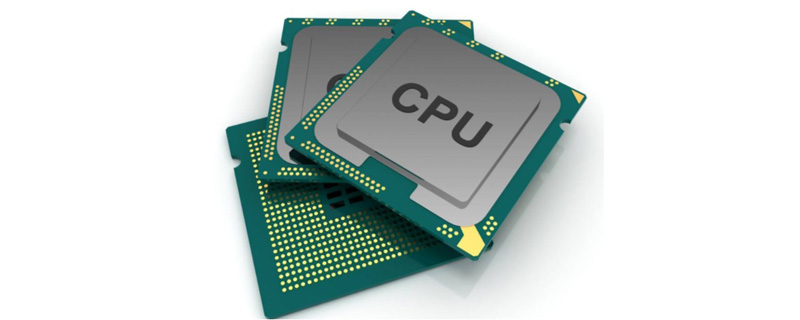What are the main performance indicators of CPU
The main performance indicators of CPU are: 1. Main frequency; 2. FSB; 3. Front-side bus FSB frequency; 4. CPU bit and word length; 5. Multiplication coefficient; 6. Cache; 7. Hyper-threading; 8. Process technology, etc.

The main performance indicators of the cpu are: main frequency, FSB, front-side bus (FSB) frequency, CPU bit and word length, multiplication factor, cache, Hyper-threading, process technology.

1. Main frequency
is the clock frequency of the CPU. Simply put, it is the CPU operating frequency.
Generally speaking, the number of instructions completed in one clock cycle is fixed, so the higher the main frequency, the faster the CPU. However, since the internal structures of various CPUs are also different, the performance of the CPU cannot be completely summarized by the main frequency.
The main frequency is related to the actual computing speed. It can only be said that the main frequency is only one aspect of CPU performance and does not represent the overall performance of the CPU.
2. FSB
The FSB is the base frequency of the CPU, the unit is MHz. The CPU's FSB determines the running speed of the entire motherboard. In layman's terms, in desktop computers, the so-called overclocking refers to overclocking the CPU's FSB (of course, under normal circumstances, the CPU multiplier is locked). I believe this is well understood.
But for server CPUs, overclocking is absolutely not allowed. As mentioned earlier, the CPU determines the running speed of the motherboard, and the two run synchronously. If the server CPU is overclocked and the FSB is changed, asynchronous operation will occur, which will cause instability in the entire server system.
3. Front-side bus (FSB) frequency
Front-side bus (FSB) frequency (i.e. bus frequency) directly affects the CPU and memory. Data exchange speed. There is a formula that can be calculated, that is, data bandwidth = (bus frequency × data bandwidth)/8. The maximum bandwidth of data transmission depends on the width and transmission frequency of all data transmitted simultaneously.
4. CPU bit and word length
Bits: Binary is used in digital circuits and computer technology, and the codes are only "0" and "1", whether it is "0" or "1", is a "bit" in the CPU.
Word length: In computer technology, the number of binary digits that the CPU can process at one time per unit time (at the same time) is called the word length.
So a CPU that can process data with a word length of 8 bits is usually called an 8-bit CPU. In the same way, a 32-bit CPU can process binary data with a word length of 32 bits per unit time.
The 8-bit CPU can only process one byte at a time, while the 32-bit CPU can process 4 bytes at a time. Similarly, the CPU with a word length of 64 bits can process 8 bytes at a time.
5. Multiplier coefficient
The multiplier coefficient refers to the relative proportional relationship between the CPU main frequency and the FSB. Under the same FSB, the higher the frequency multiplier, the higher the CPU frequency. But in fact, under the premise of the same FSB, a high-multiplier CPU itself is of little significance.
This is because the data transmission speed between the CPU and the system is limited. Blindly pursuing high multipliers and obtaining high frequency CPUs will have an obvious "bottleneck" effect - the CPU obtains data from the system. The ultimate speed cannot meet the speed of CPU operation.
6. Cache
The cache size is also one of the important indicators of the CPU, and the structure and size of the cache have a great impact on the CPU speed. , the running frequency of the cache in the CPU is extremely high. It generally operates at the same frequency as the processor, and its working efficiency is much greater than that of the system memory and hard disk.
During actual work, the CPU often needs to read the same data block repeatedly, and the increase in cache capacity can greatly improve the hit rate of reading data within the CPU without having to search for it in the memory or hard disk. , to improve system performance. However, due to factors such as CPU chip area and cost, the cache is very small.
7. Hyper-Threading
You can execute multiple threads at the same time, which can make the CPU more efficient. That is Hyper-Threading (Hyper-Threading) technology. Hyper-Threading The technology reduces the waste of system resources and can simulate one CPU into two CPUs, making more effective use of resources to improve performance at the same time.
8. Process technology
#The smaller the process, the smaller the heat generation, so more transistors can be integrated and the CPU efficiency will be higher. high.
The above is the detailed content of What are the main performance indicators of CPU. For more information, please follow other related articles on the PHP Chinese website!

Hot AI Tools

Undresser.AI Undress
AI-powered app for creating realistic nude photos

AI Clothes Remover
Online AI tool for removing clothes from photos.

Undress AI Tool
Undress images for free

Clothoff.io
AI clothes remover

Video Face Swap
Swap faces in any video effortlessly with our completely free AI face swap tool!

Hot Article

Hot Tools

Notepad++7.3.1
Easy-to-use and free code editor

SublimeText3 Chinese version
Chinese version, very easy to use

Zend Studio 13.0.1
Powerful PHP integrated development environment

Dreamweaver CS6
Visual web development tools

SublimeText3 Mac version
God-level code editing software (SublimeText3)

Hot Topics
 What should the CPU utilization be when gaming?
Feb 19, 2024 am 11:21 AM
What should the CPU utilization be when gaming?
Feb 19, 2024 am 11:21 AM
It's common for games to slow down your computer because they consume a lot of resources. It's crucial to understand your CPU usage when gaming so you can avoid overloading it. Therefore, keeping track of appropriate CPU usage is key to keeping your gaming experience smooth. In this article, we'll look at the appropriate CPU usage you should achieve while your game is running. CPU utilization during gaming CPU utilization is an important indicator of processor workload and depends on the performance specifications of the CPU. More powerful CPUs generally have higher usage. A CPU with more cores and threads can improve the overall performance of your system. Multi-threading support helps unleash the full potential of your CPU. In games, CPU usage depends on processor utilization, which can affect the game
 How to set CPU performance to full in Win11
Feb 19, 2024 pm 07:42 PM
How to set CPU performance to full in Win11
Feb 19, 2024 pm 07:42 PM
Many users find that the computer is not running smoothly enough when using the Win11 system. They want to improve CPU performance, but they don't know how to do it. The following will introduce in detail how to set the CPU performance to the highest level in Win11 system to make your computer more efficient. Setting method: 1. Right-click "This PC" on the desktop and select "Properties" in the option list. 2. After entering the new interface, click "Advanced System Settings" in "Related Links". 3. In the window that opens, click the "Advanced" tab at the top, then click the & at the bottom of "Performance"
 How to increase the clock frequency of your computer's CPU
Feb 20, 2024 am 09:54 AM
How to increase the clock frequency of your computer's CPU
Feb 20, 2024 am 09:54 AM
How to Overclock Computer CPUs With the continuous advancement of technology, people's demand for computer performance is also getting higher and higher. An effective way to improve computer performance is to increase the CPU's operating frequency through overclocking. Overclocking allows the CPU to process data faster, providing higher computing power. So, how to overclock a computer CPU? The following will introduce you to the basic principles and specific operation methods of overclocking. First, let's understand how overclocking works. The operating frequency of the CPU is determined by the crystal oscillator on the motherboard
 How to undervolt and overclock your CPU using Intel XTU
Feb 19, 2024 am 11:06 AM
How to undervolt and overclock your CPU using Intel XTU
Feb 19, 2024 am 11:06 AM
Intel XTU is a powerful application that allows you to easily manage your computer's performance. You can fix overheating issues by adjusting the CPU voltage, or boost performance by overclocking. In this article, we'll look at how you can take advantage of Intel XTU to optimize your computer's performance, whether that's adjusting voltage or overclocking. What effect do undervolting and overclocking have on the CPU? Before we move on to learning how to undervolt and overclock a CPU, we first have to understand what they are. Undervolting refers to gradually reducing the voltage required by the CPU. This process helps reduce heat emissions, as high voltage results in higher temperatures. By reducing the voltage supply to the CPU, the temperature can be effectively reduced. If your laptop starts to slow down after getting hot, you should solve the problem promptly.
 The difference between boxed and bulk cpu
Jan 23, 2024 am 09:46 AM
The difference between boxed and bulk cpu
Jan 23, 2024 am 09:46 AM
The differences between boxed and bulk CPUs: 1. Quality; 2. Warranty period; 3. Fan; 4. Price; 5. Packaging; 6. Sales channels. Detailed introduction: 1. Quality, whether it is boxed or bulk, there is no difference in the quality of the CPU itself. They are all manufactured by the same manufacturer and undergo the same quality testing and quality control process; 2. Warranty period, boxed CPU A longer warranty period is usually provided, usually three years, while bulk CPUs usually only have a one-year warranty, this is because boxed CPUs are usually sold by official or authorized dealers, etc.
 The operation process of WIN10 service host occupying too much CPU
Mar 27, 2024 pm 02:41 PM
The operation process of WIN10 service host occupying too much CPU
Mar 27, 2024 pm 02:41 PM
1. First, we right-click the blank space of the taskbar and select the [Task Manager] option, or right-click the start logo, and then select the [Task Manager] option. 2. In the opened Task Manager interface, we click the [Services] tab on the far right. 3. In the opened [Service] tab, click the [Open Service] option below. 4. In the [Services] window that opens, right-click the [InternetConnectionSharing(ICS)] service, and then select the [Properties] option. 5. In the properties window that opens, change [Open with] to [Disabled], click [Apply] and then click [OK]. 6. Click the start logo, then click the shutdown button, select [Restart], and complete the computer restart.
 144-core, 3D-stacked SRAM: Fujitsu details next-generation data center processor MONAKA
Jul 29, 2024 am 11:40 AM
144-core, 3D-stacked SRAM: Fujitsu details next-generation data center processor MONAKA
Jul 29, 2024 am 11:40 AM
According to news from this website on July 28, foreign media TechRader reported that Fujitsu introduced in detail the FUJITSU-MONAKA (hereinafter referred to as MONAKA) processor planned to be shipped in 2027. MONAKACPU is based on the "cloud native 3D many-core" architecture and adopts the Arm instruction set. It is oriented to the data center, edge and telecommunications fields. It is suitable for AI computing and can realize mainframe-level RAS1. Fujitsu said that MONAKA will achieve a leap in energy efficiency and performance: thanks to technologies such as ultra-low voltage (ULV) technology, the CPU can achieve 2 times the energy efficiency of competing products in 2027, and cooling does not require water cooling; in addition, the application performance of the processor It can also reach twice as much as your opponent. In terms of instructions, MONAKA is equipped with vector
 Leak reveals key specs of Intel Arrow Lake-U, -H, -HX and -S
Jun 15, 2024 pm 09:49 PM
Leak reveals key specs of Intel Arrow Lake-U, -H, -HX and -S
Jun 15, 2024 pm 09:49 PM
IntelArrowLakeisexpectedtobebasedonthesameprocessorarchitectureasLunarLake,meaningthatIntel'sbrandnewLionCoveperformancecoreswillbecombinedwiththeeconomicalSkymontefficiencycores.WhileLunarLakeisonlyavailableasava





